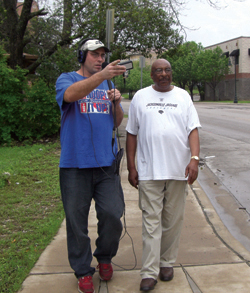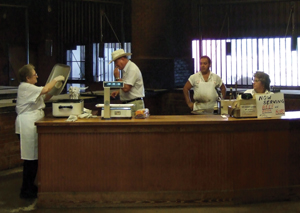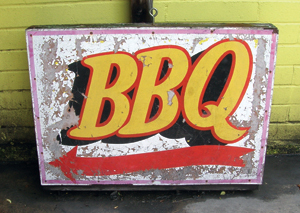Stories of Texas barbecue with heaping servings of places, people and tall tales
In Texas, barbecue is serious business. Be it ribs, brisket, sausage or something more exotic, barbecue to Texans is not just food — it’s a frame of mind.
So what is it about barbecue that Texans hold so near and dear to their hearts? Is it the savory taste of wood smoke and meat so tender you can pull it apart with your fingers? Or is it the sweet aroma of smoke wafting through a soft summer breeze that reminds us of a simpler time, when families enjoyed the pleasures of no-rush cooking in the great outdoors?
According to Elizabeth Engelhardt, associate professor of American studies at The University of Texas at Austin, barbecue not only tantalizes the taste buds, it evokes a nostalgic remembrance of yesteryear.
“Barbecue is quickly tied up with ideas of authenticity, nostalgia and a simpler time,” Engelhardt says. “There’s something really important underneath that, but to find out you need to listen to a story.”
On a quest to hear the stories of Texas’ uniquely smoky heritage, Engelhardt and 11 of her graduate students set out to collect, document and preserve oral histories from the people who make barbecue happen in Central Texas.
The 25 interviews along with 16 essays and 64 photos, are published in their forthcoming book “Republic of Barbecue: Stories Behind the Brisket,” (University of Texas Press, Oct. 2009).

The researchers’ behind-the-counter journey took them from popular chain barbecue restaurants to legendary venues like Lockhart’s Kreuz Market and Driftwood’s Salt Lick to small, owner-operated businesses with slamming screen doors and picnic tables.
While enjoying a mouthwatering cascade of brisket, sausage, ribs and chicken, along with generous portions of coleslaw, cobbler and spongy white bread, the team discovered the story of barbecue in Texas is much more than the smoky goodness on their plates. It is the story of regional pride and strong family values.
Exploring the people and places of Texas’ barbecue nation, the authors documented a vast array of themes including manliness and meat, new technology, civil rights, small-town Texas identity and intrinsically Texan drinks such as Big Red, Dr Pepper, Shiner Bock and Lone Star beer.
“We really wanted to take all those lenses that we use to look at American culture, such as gender, technology, race, environment, ethnicity and history, and apply that to barbecue,” says American studies graduate student Lisa Powell.
When Luke Zimmermann, the president of the Central Texas Barbecue Association and owner of Austin’s Ruby’s, asked Engelhardt to help his group collect stories of barbecue culture in Central Texas, she couldn’t resist the opportunity to explore the world of barbecue in and around her own community. Partnered with the Southern Foodways Alliance at the University of Mississippi, Engelhardt and Zimmermann began to imagine ways to create a picture of Texas’ dynamic world of barbecue.
The project took off after she pitched the idea to a group of graduate students in her American Foodways class. The diverse group of scholars includes native Texans, people from other barbecue strongholds of the South, a Chicagoan and even a couple of Northeasterners.
“The party in this particular book is like a big community potluck—both in the makeup of the team behind it and in its overall organization,” Engelhardt says.
The Winds of Change
Although most barbecue joints hearken back to a bygone era with sawdust on the floors and creaky wooden picnic tables, patrons may be surprised to learn many local favorites are perfecting their meats with new approaches to technology.
“It’s important to think of it as an evolving dynamic culture,” Engelhardt says. “Even the most treasured tradition in barbecue was invented by someone, and when they did it, it was cutting-edge technology.”
A prime example of technology transformation, Engelhardt points out, is how Smokey Denmark’s, an Austin-based, family-owned and operated company, smokes its sausage products. Wireless probes embedded with temperature sensors are inserted in the sausages and communicate with a server in Dallas. With this technology, the owners can log on from any computer to monitor the exact temperature of the sausage during the entire process. This is a far cry from lifting the lid of a smoker and peeking at the temperature.
“Texas barbecue is a fast-changing, evolving world,” Engelhardt says. “And as producers and consumers of Texas barbecue experiment with new technology, they may redefine the notion of ‘authentic’ barbecue entirely.”
And as consumers’ tastes change, so do the menu items. In addition to the ubiquitous sides of pickles, white bread and onions, more dishes, sauces and seasonings are being added to the mix. At the original Kreuz Market, the owner began putting bottles of hot sauce on the tables after noticing Latino customers regularly purchased hot sauce from its store to slather on the barbecue.
To meet growing environmental concerns, many restaurants are using biodegradable to-go containers, reusable cloth napkins and sustainable wood for their fire pits. And other modifications, like all-organic condiments and sides are on their way, says Engelhardt.
Veering off the culinary path, the researchers met with Ronnie Vinikoff, owner and operator of Forestry Management in Rockdale, 60 miles northeast of Austin. Managing 15,000 acres of land in several counties, Vinkoff removes diseased or dying trees from wooded areas to allow healthy trees to soak in sunlight, water and soil nutrients. The wood is then supplied to barbecue establishments in and around Austin.
Although the concept of “green barbecue” may raise a few eyebrows, Vinkoff’s long waiting list of restaurants asking for his wood suggests many barbecue establishments want to contribute to the greening of Austin.
“We can’t just assume a restaurant’s menu items, its smoking methods or even its surroundings will remain the same throughout the years,” Engelhardt says. “Perhaps the definition of authenticity depends on how restaurant owners accommodate to gradual changes over time.”

For more than 36 years Ben Wash, former owner of Ben’s Long Branch Barbecue, kept his doors open during times of great transition on East Austin’s Eleventh Street, an area known as the heart of the city’s African-American life. During an interview with the longtime pit master, the researchers noticed his knack for creating a warm, welcoming environment, where people gather over throngs of smoked meat to share stories, laugh and reminisce about the neighborhood’s drastic changes. Wash recalled his struggles keeping his business afloat when the area steadily declined as wealthier residents moved out and many black-owned businesses closed or relocated to areas with better economic prospects.
Although Wash’s restaurant is no longer open for business, many of Austin’s East Side residents remember it as one of the last remaining links to the African-American history of the neighborhood.
“It was important to Ben to preserve some kind of memory of history of his neighborhood,” Engelhardt says. “The way he talked about the history of the buildings and the connections between his neighbors showed how deeply he cared about his community.”
A Melting Pot of Barbecue
Many other states (North Carolina, Tennessee and Missouri, to name a few) consider themselves the Holy Grail of barbecue destinations, but Engelhardt says Lone Star barbecue is unique in its own right.
“Of course other states love their barbecue — and their barbecues are important to their history, culture and character,” Engelhardt says. “But, I would argue, Texas barbecue is special because Texans of diverse races, ethnicities, classes and genders all contributed to it. Barbecue nourishes and supports all those Texans around a big symbolic table. You would have to look a long time to find such diversity, pride and community in barbecue.”

Many Texans will say it’s all about the beef. But it turns out, Texas barbecue, a fusion of sausage, venison, turkey, cabrito, barbacoa and mutton, is a mixture of traditions practiced and nurtured by a variety of cultures.
Each of these groups, including trail-riding cowboys, German and Czech butchers, Hispanic horsemen and both free and enslaved African Americans, introduced many different ingredients and cooking practices to Texas barbecue. Although the dominant origin story includes ranch hands roasting beef over makeshift pits during cattle drives, descriptions of pit barbecue can be found in records as far back as Christopher Columbus.
Revealing Texas’ true melting-pot nature, the team interviewed more than 25 people of all ages, races and socioeconomic backgrounds who were manning the pits, all with unique and often surprising stories to share. The interviews and audio clips are available on the Southern Foodways Alliance Web site (www.southernbbqtrail.com).
“If you look at most of the coverage of barbecue, whether it be on TV or in a book, it’s always focused on the pit master, who is almost invariably a middle-aged white man from Texas,” says American studies graduate student Carly Kocurek. “We really wanted to see who else is functioning in that arena.”
Disrupting the common myths of Texas barbecue as an exclusive boys’ club, the team found many well-known barbecue restaurants are owned or co-owned by women such as Nina Schmidt Sell of Smitty’s Market in Lockhart, Charlotte Finch of the Iron Works in Austin, and Hisako Roberts of the Salt Lick in Driftwood.
But the world of barbecue is still commonly portrayed as a man’s game because most of the women are working outside of the limelight as waitresses, bookkeepers and cashiers, while the men slice the meat and man the pits, Engelhardt said.
Altering the gender code of Texas barbecue, Nikki Dugas created Barbecuties, a women-run street kiosk that was once parked on Sixth Street in Austin. Criticized for using sex and their bodies to sell barbecue, the scantily-clad waitresses served steaming plates of barbecue to late night crowds of bar-goers, encouraging customers to toss some bills in their tip jar labeled “tips for our boob jobs.”
The brazen pit mistress made no secret of her propane meat smoker, a cooking technique that many barbecue aficionados dismiss as “inauthentic.” But when she confessed that she didn’t smoke her meat the old-fashioned way, she said she’s not the only one using propane or electricity — a truth fleshed out by Engelhardt and her researchers.
So what exactly constitutes as “authentic” barbecue? For a word that comes up so often, the question is not easy to answer, says Engelhardt.
“We were not on a quest to judge what counts as ‘true’ barbecue,” Engelhardt says. “Our research stems from our appreciation of the complexities of Texas cultures. We talked to people from all walks of life who use mass-produced rotisserie pits and propane burners, as well as those who use the traditional brick pits and woodpiles — if some folks call it barbecue, and others agree, then we wanted to hear their stories.”
Despite their steadfast research of barbecue joints peppered throughout Central Texas, Engelhardt says she still doesn’t know everything about barbecue. The stories continue to surprise her, and she never gets tired of hearing them.
“Owning and operating a barbecue establishment is hard work,” Engelhardt says, smiling. “But they all feel lucky to be able to make a living doing what they love. To them, barbecue is much more than a job; it’s a way of life. They’re living their version of the American dream.”
Music and Texas Barbecue
During the researchers’ two-year long barbecue crawl, they discovered a plethora of themes to explore. One topic that couldn’t be ignored — especially in Austin — is the connection between barbecue and music.
“People would tell stories about songs that referred to their favorite barbecue place, or about the musicians who frequented their restaurants,” Engelhardt says.
With barbecue’s cultural ties to country music, it’s no mystery why barbecue is ubiquitous at honky-tonk havens throughout the Lone Star state. But the team was surprised to discover venues of all music genres are also linked to Texas’ signature dish.
Kocurek, who also works as a freelance music journalist, said she sees pounds of brisket piled on tables at music venues at Austin’s nationally famous music, film and new-media festival South by Southwest.
“It’s interesting to see a strange conglomeration of people — from British-emo-pop artists to indie rockers to singer songwriters — eating barbecue,” graduate student Carly Kocurek adds.
Many country music icons have immortalized their love for barbecue in songs. Here is a sampling of Engelhardt’s barbecue playlist in “Republic of Barbecue,” titled “Barbecue Melodies: Post Oak Smoke Gets in Their Eyes.”
- ZZ Top “Bar-B-Q”
- Tim McGraw “Barbecue Stain”
- Robert Earl Keen “Barbeque”
- Louis Armstrong
- “Struttin’ with Some Barbecue”
- Clarence “Gatemouth” Brown “Sherriff’s Barbecue”
- Louis Armstrong and
- Don Ray “Samba with Some Barbecue”
- Phish’s Trey Anastasio
- “At the Barbecue”
- Jack McDuff “Hot Barbecue”
- Barbecue Bob
- “Barbecue Blues”
- Bessie Jackson
- “Barbecue Bess”
- Joe Ely “BBQ and Foam”
